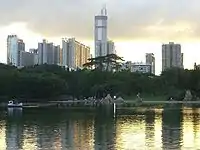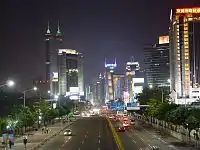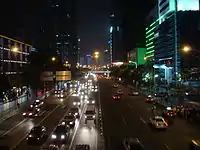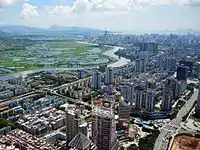ရှိန်းကျိန့်မြို့
ရှိန်းကျိန့်မြို့ (တရုတ်: 深圳 မန်းဒရင်း အသံထွက်: [ʂə́ntʂə̂n]) သည် တရုတ်နိုင်ငံတောင်ပိုင်း၊ ကွမ်တုံပြည်နယ်ရှိ အဓိကမြို့ကြီးတစ်မြို့ဖြစ်ပြီး ဟောင်ကောင်၏မြောက်ဖက်တွင်ကပ်လျက်တည်ရှိသည်။ ယင်းဒေသသည် တရုတ်နိုင်ငံ၏ပထမဆုံးသော အထူးစီးပွားရေးဇုန်ဖြစ်သည်။ လက်ရှိတွင်လည်း ပြည်နယ်အဆင့်ထက်အနည်းငယ်သာနိမ့်သော ပြည်နယ်ခွဲအနေအထားအုပ်ချုပ်ရေးတည်ရှိလျက်ရှိသည်။
| ရှိန်းကျိန့်မြို့ 深圳 | |
|---|---|
| Sub-provincial city | |
| 深圳市 | |
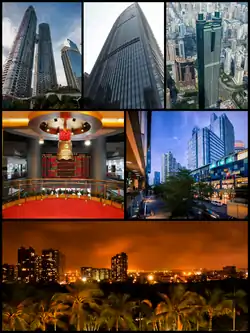 | |
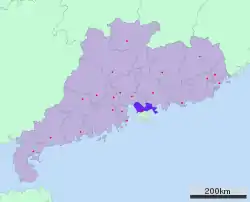 ကွမ်တုံးပြည်နယ်တွင် ရှိန်းကျိန့်မြို့၏တည်နေရာပြပုံ | |
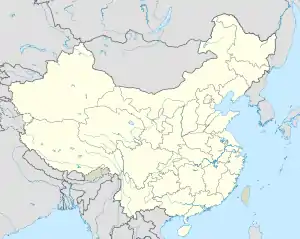 ရှိန်းကျိန့်မြို့ | |
| ကိုဩဒိနိတ်: 22°33′N 114°06′E | |
| နိုင်ငံ | တရုတ်ပြည်သူ့သမ္မတနိုင်ငံ |
| ပြည်နယ် | ကွမ်တုန်းပြည်နယ် |
| County-level divisions | ၆ |
| အထူးစီးပွားရေးဇုန် ဖွဲ့စည်းခြင်း | 1 May 1980 |
| အစိုးရ | |
| • အမျိုးအစား | ပြည်နယ်ခွဲအဆင့်မြို့ |
| ဧရိယာ | |
| • Sub-provincial city | ၂၀၅၀ စတုရန်းကီလိုမီတာ (၇၉၀ စတုရန်းမိုင်) |
| • မြို့ပေါ် | ၄၁၂ စတုရန်းကီလိုမီတာ (၁၅၉ စတုရန်းမိုင်) |
| ပင်လယ်ရေ မျက်နှာပြင်အမြင့် | ၁၂ မီတာ (၄၀ ပေ) |
| လူဦးရေ (၂၀၁၀)[1] | |
| • Sub-provincial city | ၁၀၃၅၇၉၃၈ |
| • သိပ်သည်းမှု | ၅၁၀၀/km၂ (၁၃၀၀၀/sq mi) |
| • မြို့ပေါ် | ၃၅၃၈၂၇၅ |
| • မြို့ပေါ် သိပ်သည်းမှု | ၈၆၀၀/km၂ (၂၂၀၀၀/sq mi) |
| • Major nationalities | Han |
| Demonym(s) | Shenzhener |
| အချိန်ဇုန် | China Standard (UTC+8) |
| ဧရိယာကုဒ်(များ) | 755 |
| GDP | 2011[1] |
| - Total | CNY 1,151 billion USD 178 billion |
| - per capita | CNY 110,421 USD 17,096 |
| - Growth | |
| Licence plate prefixes | 粤B |
| ဝက်ဘ်ဆိုဒ် | (အင်္ဂလိပ်) sz.gov.cn |
| ရှိန်းကျိန့်မြို့ | |||||||||||||||||||||||||||
 "Shenzhen", as written in Chinese | |||||||||||||||||||||||||||
| တရုတ် | 深圳 | ||||||||||||||||||||||||||
|---|---|---|---|---|---|---|---|---|---|---|---|---|---|---|---|---|---|---|---|---|---|---|---|---|---|---|---|
| Cantonese Yale | sāmjan | ||||||||||||||||||||||||||
| Cantonese Jyutping | Sam1 zan3 | ||||||||||||||||||||||||||
| Hanyu Pinyin | Shēnzhèn | ||||||||||||||||||||||||||
| ဆိုလိုရင်း | deep drains | ||||||||||||||||||||||||||
| |||||||||||||||||||||||||||
Shenzhen's modern cityscape is the result of the vibrant economy made possible by rapid foreign investment since the institution of the policy of "reform and opening" establishment of the SEZ in the late 1979, before which it was only a small village. Both Chinese and foreign nationals have invested enormous amounts of money in the Shenzhen SEZ. More than US$30 billion in foreign investment has gone into both foreign-owned and joint ventures, at first mainly in manufacturing but more recently in the service industries as well. Shenzhen is now considered one of the fastest-growing cities in the world.[2]
တရုတ်ပြည်မကြီးတောင်ပိုင်းရှိဘဏ္ဍာရေးဗဟိုဌာနဖြစ်သည့်အားလျော်စွာ ရှိန်းကျိန့်မြို့သည် ရှိန်းကျိန့်စတော့အိတ်ချိန်းနှင့်အခြားအဆင့်မြင့်နည်းပညာကုမ္ပဏီများ၏ရုံးစိုက်ရာမြို့ဖြစ်သည်။ ရှိန်းကျိန့်မြို့သည် တရုတ်နိုင်ငံ၏ ကုန်သေတ္တာတင်ပို့သည့် အစည်ကားဆုံးဆိပ်ကမ်းများတွင်တစ်ခုအပါအဝင်ဖြစ်သည်။
ရာဇဝင်
Human habitation in Shenzhen dates back to ancient times. The earliest archaeological remains so far unearthed are shards from a site at Xiantouling on Mirs Bay, dating back to 5000 BC. From the Han Dynasty (third century BC) onwards, the area around Shenzhen was a centre of the salt monopoly, thus meriting special Imperial protection. Salt pans are still visible around the Pearl River area to the west of the city and are commemorated in the name of the Yantian container terminal (盐田, meaning “salt fields”).
The settlement at Nantou was the political centre of the area from early antiquity. In the year 331 AD, six counties covering most of modern south-eastern Guangdong were merged into one province or “jun” named Dongguan Jun with its centre at Nantou. As well as being a centre of the politically and fiscally critical salt trade, the area had strategic importance as a stopping off point for international trade. The main shipping route to India, Arabia and the Byzantine Empire started at Canton. As early as the eighth century, chronicles record the Nantou area as being a major commercial centre, and reported that all foreign ships in the Canton trade would stop there. It was also as a naval defence centre guarding the southern approaches to the Pearl River.[3]
Shenzhen was also involved in the events surrounding the end of the Southern Song Dynasty (1276–79). The Imperial court, fleeing Kublai Khan's forces, established itself in the Shenzhen area and the last Emperor died strapped to the back of his chief Minister who preferred suicide to the possibility of the Emperor being captured and bringing shame to the dynasty. In the late 19th century the Chiu or Zhao (Zhao was the Song Imperial surname)clan in Hong Kong identified the Chiwan area as the final resting place of the Emperor and built a tomb to him. The tomb, since restored, is still in Chiwan.[4]
Earliest known ancient records that carried the name of Shenzhen date from 1410 during the Ming Dynasty. Local people called the drains in paddy fields “zhen” (圳). Shenzhen (深圳) literally means “deep drains” as the area was once crisscrossed with rivers and streams, with deep drains within the paddy fields. The character 圳 is limited in distribution to an area of South China with its most northerly examples in Zhejiang Province which suggests an association with southwards migration during the Southern Song Dynasty (12th and 13th centuries).[5] The County town at Xin'an in modern Nanshan dates from the Ming Dynasty where it was a major naval centre at the mouth of the Pearl River. In this capacity it was heavily involved in 1521 in the successful Chinese action against the Portuguese Fleet under Fernão Pires de Andrade. This battle, called the Battle of Tunmen, was fought in the straits between Shekou and Lintin Island.[3]
Shenzhen was singled out to be the first of the five Special Economic Zones (SEZ). It was formally established in 1979 due to its proximity to Hong Kong. The SEZ was created to be an experimental ground for the practice of market capitalism within a community guided by the ideals of "socialism with Chinese characteristics".[6]
Shenzhen eventually became one of the largest cities in the Pearl River Delta region, which has become one of the economic powerhouses of China as well as the largest manufacturing base in the world.
In November 1979, Shenzhen, then known as Bao'an County (宝安县), was promoted to prefecture level, directly governed by Guangdong province. In May 1980, Shenzhen was formally nominated as a "special economic zone", the first one of its kind in China. It was given the right of provincial-level economic administration in November 1988.
For five months in 1996, Shenzhen was home to the Provisional Legislative Council and Provisional Executive Council of Hong Kong.
Geography
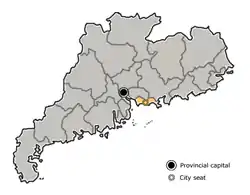
| Shenzhen | ||||||||||||||||||||||||||||||||||||||||||||||||||||||||||||
|---|---|---|---|---|---|---|---|---|---|---|---|---|---|---|---|---|---|---|---|---|---|---|---|---|---|---|---|---|---|---|---|---|---|---|---|---|---|---|---|---|---|---|---|---|---|---|---|---|---|---|---|---|---|---|---|---|---|---|---|---|
| Climate chart (explanation) | ||||||||||||||||||||||||||||||||||||||||||||||||||||||||||||
| ||||||||||||||||||||||||||||||||||||||||||||||||||||||||||||
| ||||||||||||||||||||||||||||||||||||||||||||||||||||||||||||
Shenzhen is located in the Pearl River Delta, bordering Hong Kong to the south, Huizhou to the north and northeast and Dongguan to the north and northwest. The municipality covers an area of ၂,၀၅၀ စတုရန်း ကီလိုမီတာ (၇၉၂ စတုရန်းမိုင်) including urban and rural areas, with a total population of 14 million in 2008.[7]
The city was originally a hilly area, with fertile agrarian land. However, after becoming a special economic zone in 1979, Shenzhen underwent tremendous change in landscape. The once hilly fishing village is now replaced by mostly flat ground in city center area, with only Lianhua Shan (Lotus Hill), Bijia Shan (Bijia Mountain) and Wutong Shan the only three places that have some kind of elevation as viewed from satellites. With the influx of migrants from inland China, Shenzhen is experiencing a second stage boom, and it is now expanding peripherally and the hills in surrounding areas such as Mission Hills are now being levelled to make land for more development.
Shenzhen is located on the border with the Hong Kong SAR across the Sham Chun River and Sha Tau Kok River, ၁၀၀ ကီလိုမီတာ (၆၂ မိုင်) southeast of the provincial capital of Guangzhou, ၆၀ ကီလိုမီတာ (၃၇ မိုင်) south of the industrial city of Dongguan and ၆၀ ကီလိုမီတာ (၃၇ မိုင်) north-northeast of the resort city of Zhuhai.
Climate
Shenzhen is situated in the subtropical part of China, located at about the Tropic of Cancer, yet due to the Siberian anticyclone, has a warm, monsoon-influenced, humid subtropical climate (Köppen Cwa). Winters are mild and relatively dry, due in part to the influence of the South China Sea, and frost is very rare. Spring begins somewhat dry, but rainfall begins to dramatically increase in April, and the rainy season lasts until early to mid October. The monsoon reaches its peak intensity in the summer months, when the city also experiences very humid, and hot, but moderated, conditions. The region is prone to torrential rain as well, with 10 days that have ၅၀ မီလီမီတာ (၁.၉၇ လက်မ) or more of rain. The latter portion of autumn is dry. The annual precipitation averages at over ၁,၉၀၀ မီလီမီတာ (၇၅ လက်မ), some of which is delivered in typhoons that strike from the east during summer and early autumn.
| Shenzhen (1971–2000) အတွက် ရာသီဥတု အချက်အလက်များ | |||||||||||||
|---|---|---|---|---|---|---|---|---|---|---|---|---|---|
| လ | ဇန်နဝါရီ | ဖေဖော်ဝါရီ | မတ် | ဧပြီ | မေ | ဇွန် | ဇူလိုင် | ဩဂုတ် | စက်တင်ဘာ | အောက်တိုဘာ | နိုဝင်ဘာ | ဒီဇင်ဘာ | နှစ် |
| ပျမ်းမျှ အမြင့်ဆုံး အပူချိန် °C (°F) | 19.7 (67.5) |
19.7 (67.5) |
22.7 (72.9) |
26.3 (79.3) |
29.3 (84.7) |
31.1 (88) |
32.2 (90) |
32.0 (89.6) |
31.2 (88.2) |
28.9 (84) |
25.1 (77.2) |
21.5 (70.7) |
26.6 (79.9) |
| နေ့စဉ် ပျမ်းမျှ °C (°F) | 14.9 (58.8) |
15.5 (59.9) |
18.7 (65.7) |
22.5 (72.5) |
25.7 (78.3) |
27.8 (82) |
28.6 (83.5) |
28.2 (82.8) |
27.2 (81) |
24.7 (76.5) |
20.4 (68.7) |
16.4 (61.5) |
22.55 (72.6) |
| ပျမ်းမျှ အနိမ့်ဆုံး အပူချိန် °C (°F) | 11.7 (53.1) |
12.7 (54.9) |
16.0 (60.8) |
19.9 (67.8) |
23.2 (73.8) |
25.2 (77.4) |
25.7 (78.3) |
25.5 (77.9) |
24.3 (75.7) |
21.6 (70.9) |
17.1 (62.8) |
12.9 (55.2) |
19.7 (67.5) |
| ပျှမ်းမျှ မိုးရေချိန် mm (inches) | 29.8 (1.173) |
44.1 (1.736) |
67.5 (2.657) |
173.6 (6.835) |
238.5 (9.39) |
296.4 (11.669) |
339.3 (13.358) |
368.0 (14.488) |
238.2 (9.378) |
99.4 (3.913) |
37.4 (1.472) |
34.2 (1.346) |
၁၉၆၆.၄ (၇၇.၄၁၅) |
| ပျမ်းမျှ မိုးရွာသွန်းရက်များ (≥ 0.1 mm) | 7.07 | 10.07 | 10.77 | 12.73 | 15.60 | 18.47 | 17.00 | 18.30 | 14.83 | 7.63 | 5.63 | 5.97 | 144.07 |
| Average relative humidity (%) | 71.7 | 76.8 | 79.5 | 81.0 | 81.7 | 81.8 | 80.5 | 81.8 | 78.8 | 72.4 | 68.4 | 67.1 | 76.8 |
| Mean monthly sunshine hours | 147.9 | 98.8 | 101.4 | 110.2 | 149.8 | 173.6 | 220.0 | 188.6 | 181.2 | 199.5 | 184.3 | 178.5 | ၁၉၃၃.၈ |
| Source: 21CMA | |||||||||||||
Administrative divisions
Shenzhen is a sub-provincial city. It has direct jurisdiction over eight districts (区 qu):
The Special Economic Zone (SEZ) comprised only Luohu, Futian, Nanshan, and Yantian districts until 1 July 2010, when the SEZ was expanded to include all districts, a fivefold increase over its pre-expansion size.
Adjacent to Hong Kong, Luohu is the financial and trading centre of Shenzhen. Futian, at the heart of the SEZ, is the seat of the Municipal Government. West of Futian, Nanshan is the centre for high-tech industries. Formerly outside the SEZ, Bao'an and Longgang are located to the north-west and north-east, respectively, of central Shenzhen. Yantian is the location of Yantian Port, the second busiest container terminal in mainland China and the fourth busiest in the world.
Demographics
| သမိုင်းတစ်လျှောက် လူဦးရေများ | ||
|---|---|---|
| ခုနှစ် | လူဦးရေ | ±% |
| 1982[8] | ၃၅၁၈၇၁ | — |
| 1990[9] | ၁၂၁၄၈၀၀ | +245.2% |
| 2000[9] | ၇၀၀၈၄၂၈ | +476.9% |
| 2010[1] | ၁၀၃၅၇၉၃၈ | +47.8% |
| Population size may be affected by changes on administrative divisions. | ||
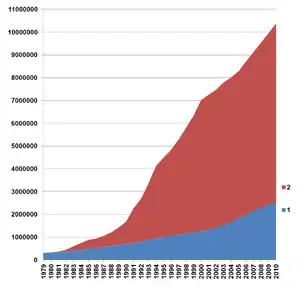
Legend:
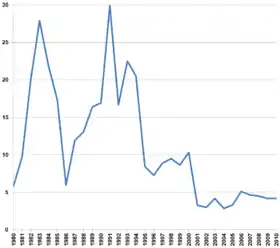
Shenzhen has seen its population and activity develop rapidly since the establishment of the SEZ. Shenzhen's population is roughly ten million. About six million of these people are migrant workers who return home on the weekends and live in factory dormitories during the week. Shenzhen is the largest migrant city in China.[10]
There had been migration into southern Guangdong and what is now Shenzhen since the Southern Song Dynasty (1127–1279) but the numbers increased dramatically since Shenzhen was established in the 1980s. In Guangdong, it is the only city where Mandarin is mostly spoken, with migrants from all over China. At present, the average age in Shenzhen is less than 30. Among the total, 8.49 percent are between the age of 0 and 14, 88.41 percent between the age of 15 and 59, one-fifth between 20 and 24 and 1.22 percent are aged 65 or above.[11]
The population structure polarizes into two opposing extremes: intellectuals with a high level of education, and migrant workers with poor education.[12] It was reported in June 2007 that over 20 percent of China's PhD's worked in Shenzhen.[13]
According to the Hong Kong General Chamber of Commerce, in 2002, 7,200 Hong Kong residents commuted daily to Shenzhen for work, and 2,200 students from Shenzhen commuted to school in Hong Kong. Though neighbouring each other, daily commuters still need to pass through customs and immigration checkpoints, as travel between the SEZ and the Hong Kong Special Administrative Region (SAR) is restricted.
In late July 2003, China relaxed travel restrictions to allow individuals from the southern cities of Guangzhou and Shenzhen, as well as Beijing and Shanghai, to visit Hong Kong. Previously, mainland travelers could only visit the city as part of tour groups. (See Individual Visit Scheme.)
Immigration into Shenzhen from the Chinese interior was previously restricted by the hukou system. One consequence is that just outside of Shenzhen, there exist large towns consisting of now settled migrants who had previously attempted to enter the city.
Languages
Prior to the establishment of Special Economic Zone, the indigenous local communities could be divided into Cantonese and Hakka,[14] which were two cultural and linguistic sub-ethnic groups vernacular to Guangdong province. In particular, the Cantonese variety spoken locally was called Weitou dialect,[15] whereas now the younger generations of the Cantonese communities are being assimilated into the more prestigious variety, known as standard Cantonese, probably because of the influence of Hong Kong's broadcasting. Today, the original inhabitants of indigenous Cantonese and Hakka communities are dispersing into more recently built urban settlements (e.g. apartments and villas), but a large proportion of them are still clustering in their traditional urban and suburban villages.[16]
Since 1980s, the unprecedented influx of immigrants drastically altered the linguistic landscape, in which Shenzhen as a whole has undergone a language shift towards Mandarin, which was both promoted by China's Central Government as a national lingua franca and natively spoken by most of the out-of-province immigrants and their descendants.[17][18] Since then, the Cantonese and Hakka indigenous populations were diluted into trivial proportions. Despite the ubiquity of Mandarin Chinese, Cantonese, Hakka, and Teochew are still spoken among people of in-province ancestries in private occasions to a lesser extent than Mandarin. Hokkien and Hunanese are also sometimes observed.
Generally speaking, in most circumstances, people who are monolingual in either Cantonese, Hakka, or Teochew are senior citizens of in-province ancestries; people who are bilingual in both Cantonese and Mandarin are the middle-aged and youngsters of Cantonese ancestry; people who are trilingual in Cantonese, Mandarin, and either Hakka or Teochew are of either Hakka ancestry or Teochew ancestry; and people who are monolingual only in Mandarin are those of out-of-province ancestry.
Mandarin native speakers, whose majority is out-of-province immigrants and their descendants are found unwilling to learn any of Cantonese, Hakka or Teochew, probably due to Mandarin's dominance, advantages, administrative legitimacy, educational priority, societal bias, and official statuses at national, provincial, and municipal levels,[19][20][21] as well as those languages' inherent complexities and difficulties.
Economy
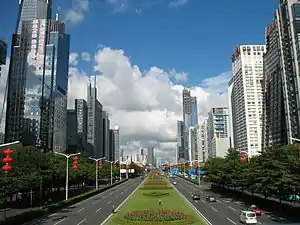
In 2001, the working population reached 3.3 million. Though the secondary sector of industry had the largest share (1.85 million in 2001, increased by 5.5%), the tertiary sector of industry is growing fast (1.44 million in 2001, increased by 11.6%). Shenzhen's GDP totaled CNY 820.1 billion in 2009, up by 10.7 percent over the previous year, with a GDP per capita of US$13,581 as of 2009. Its economy grew by 16.3 percent yearly from 2001 to 2005 on average. The proportion of the three industries to the aggregate of GDP was 0.1:46.7:53.2 in 2009. The proportion of the primary industry to GDP was down by 13.4%, and the tertiary industry was up by 12.5%. Shenzhen is in the top ranks among mainland Chinese cities in terms of comprehensive economic power. It ranked fourth in GDP among mainland Chinese cities in 2001, while it ranked the top in GDP per capita during the same period. Its import and export volumes have been first for the last nine consecutive years. It is the second in terms of industrial output. For five consecutive years, its internal revenue within local budget ranks third. It also ranks third in the use of foreign capital.
Shenzhen is a major manufacturing center in China. In the 1990s, Shenzhen was described as constructing "one highrise a day and one boulevard every three days". The Shenzhen's rapidly growing skyline is regarded as one of the best in the world.[22] It currently has 26 buildings at over 200 meters tall, including the Shun Hing Square (the 19th tallest building in the world).[23]
Shenzhen is home to some of China's most successful high-tech companies, such as BYD, Dingoo, G'Five, Hasee, Huawei, JXD, Konka, Netac, Skyworth, Tencent and ZTE. BYD, Hasee and Huawei are headquartered in the Longgang District.[24] TCL Corporation, best known as China's number one TV brand, has a presence in the city. Taiwan's largest company Hon Hai Group (Foxconn) has a manufacturing plant based in Shenzhen. Many foreign high-tech companies have their operations in the Science and Technology park in Nanshan District or outside the core districts where labor and land are much cheaper. CSG Holding is the largest architectural glass manufacturer in China. Vanke is the largest residential real estate developer in China. In the financial sector, Shenzhen Development Bank, China Merchants Bank and Shenzhen City Commercial Bank are some of the largest banks in China, with headquarters in Shenzhen.
Shenzhen Convention & Exhibition Center is a super large public construction with multi-functions of hosting business activities, celebrations, conferences, conventions, entertainment events, exhibitions, restaurants and all kinds of shows.
In 2010, the GDP reached a record high of 951 billion yuan, an increase of 10.7% over 2009. Shenzhen's economic output is ranked fourth among the 659 Chinese cities (behind Beijing, Shanghai and Guangzhou), and it is comparable to that of a medium sized province in China. In 2010, Shenzhen's GDP per capita was 95,000 yuan (US$14,615), making it one of the richest of all Chinese cities.
On 1 July 2010 the Shenzhen special economic zone was expanded from ၃၉၆ စတုရန်း ကီလိုမီတာ (၁၅၃ စတုရန်းမိုင်) to ၁,၉၅၃ စတုရန်း ကီလိုမီတာ (၇၅၄ စတုရန်းမိုင်) and border controls with the rest of China relaxed. တမ်းပလိတ်:Clarify[25]
Industrial zones
- Shenzhen Hi-Tech Industrial Park (SHIP) was founded in September 1996. It covers an area of ၁၁.၅ km2 (၄.၄ sq mi). Industries encouraged in the zone include Biotechnology/Pharmaceuticals, Building/Construction Materials, Chemicals Production and Processing, Computer Software, Electronics Assembly & Manufacturing, Instruments & Industrial Equipment Production, Medical Equipment and Supplies, Research and Development, Telecommunications Equipment.[26]
- Shenzhen Software Park is integrated with Shenzhen Hi-Tech Industry Park, an important vehicle established by Shenzhen Municipal Government to support the development of software industry. The Park was approved to be the base of software production of the National Plan in 2001. The distance between the 010 National Highway and the zone is ၂၀.၈ km (၁၂.၉ mi). The zone is situated ၂၂ km (၁၄ mi) from the Shenzhen Bao'an International Airport.[27]
Shenzhen Stock Exchange
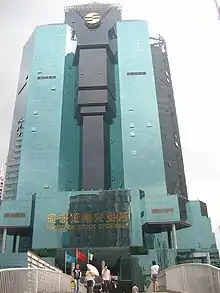
The Shenzhen Stock Exchange (SZSE) is a mutualized national stock exchange under the China Securities Regulatory Commission (the CSRC) that provides a venue for securities trading. A broad spectrum of market participants, including 540 listed companies, 35 million registered investors and 177 exchange members, create the market. Since its creation in 1990, the SZSE has grown with a market capitalization around 1 trillion yuan (US$122 billion). On a daily basis, around 600,000 deals, valued at US$807 million, trade on the SZSE.
Cityscape
The tallest building in Shenzhen is now Kingkey 100, which rises to ၄၄၁.၈ မီတာ (၁,၄၄၉ ပေ) and contains 100 floors for office space and a hotel. It is currently the tallest building in Shenzhen as well as one of the tallest buildings in southern China. Shenzhen is also the home to the world's 14th tallest building, the Shun Hing Square (Diwang Building). The city has 23 buildings over ၂၀၀ m (၆၅၆ ft), mostly concentrated in Luohu and Futian districts. The second tallest building in Shenzhen is SEG Plaza at a height of 356 meters (292 meters to roof-top), located in the popular electronics district of Hua Qiang Bei.
Shenzhen has some of the largest public projects in China. The International Trade Center (国贸), built in 1985, was the tallest building in China when built, and the Shun Hing building was also the tallest in Asia when it was built (still the tallest steel building in the world). Shenzhen is also the site for many tall building projects. Some of the supertalls that have been either proposed or approved are well over ၄၀၀ m (၁,၃၁၂ ft). Other proposed buildings would surpass the Kingkey 100's height by 2015.
For example, the ၆၄၆ m (၂,၁၁၉ ft) tall Pingan International Finance Centre will be the tallest in China and second tallest building in the world upon completion in 2014, after the Burj Khalifa. See list of tallest buildings in Shenzhen.
Gallery
|
Integration with Hong Kong
Hong Kong and Shenzhen have very close business, trade and social links as demonstrated by the statistics presented below. Except where noted the statistics are taken from sections of the Hong Kong Government (HKG) website.[28]
As of December 2007, there are six land crossing points on the boundary between Shenzhen and Hong Kong. From west to east these are Shenzhen Bay Port road crossing (opened 1 July 2007); Fu Tian Kou An to Lok Ma Chau rail connection linking Shenzhen Metro Line 4 to the MTR's East Rail Line Lok Ma Chau Spur Line (opened 15 August 2007); Huanggang to Lok Ma Chau road connection; Futian to Man Kam To road connection; Luohu to Lo Wu rail connection linking the MTR East Rail Line to Shenzhen Metro Line 1, Shenzhen Rail Station and Luohu in general; and the Shatoujiao to Sha Tau Kok road connection.[29] Both of the rail connections require the passengers to cross the Shenzhen River on foot as there is no direct rail connection between the two cities, although the Hong Kong intercity trains to other mainland cities pass through Shenzhen without stopping.
In 2006, there were around 20,500 daily vehicular crossings of the boundary in each direction. Of these 65 percent were cargo vehicles, 27 percent cars and the remainder buses and coaches. The Huanggang crossing was most heavily used at 76 percent of the total, followed by the Futian crossing at 18 percent and Shatoujiao at 6 percent.[30] Of the cargo vehicles, 12,000 per day were container carrying and, using a rate of 1.44 teus/vehicle, this results in 17,000 teus/day across the boundary,[31] while Hong Kong port handled 23,000 teus/day during 2006, excluding transshipment trade.[32]
Trade with Hong Kong in 2006 consisted of US$333 billion of imports of which US$298 billion were re-exported. Of these figures 94 percent were associated with China.[33] Considering that 34.5 percent of the value of Hong Kong trade is air freight (only 1.3 percent by weight), a large proportion of this is associated with China as well.[34]
Also in 2006 the average daily passenger flow through the four connections open at that time was over 200,000 in each direction of which 63 percent used the Luohu rail connection and 33 percent the Huanggang road connection.[29] Naturally, such high volumes require special handling, and the largest group of people crossing the boundary, Hong Kong residents with Chinese citizenship, use only a biometric ID card (Home Return Permit) and a thumb print reader. As a point of comparison, Hong Kong’s Chek Lap Kok Airport, the 5th busiest international airport in the world, handled 59,000 passengers per day in each direction.[34]
Hong Kong conducts regular surveys of cross-boundary passenger movements, with the most recent being in 2003, although the 2007 survey will be reported on soon. In 2003 the boundary crossings for Hong Kong Residents living in Hong Kong made 78 percent of the trips, up by 33 percent from 1999, whereas Hong Kong and Chinese residents of China made up 20 percent in 2006, an increase of 140 percent above the 1999 figure. Since that time movement has been made much easier for China residents, and so that group have probably increased further yet. Other nationalities made up 2 percent of boundary crossings. Of these trips 67 percent were associated with Shenzhen and 42 percent were for business or work purposes. Of the non-business trips about one third were to visit friends and relatives and the remainder for leisure.[35]
Future integration plans
In Section 114(1) of the policy address on 10 October 2007,[36] Donald Tsang, Hong Kong Chief Executive, stated:
Jointly developing a world-class metropolis with Shenzhen: In my Election Platform, I have put forward the vision of developing the Hong Kong-Shenzhen metropolis and undertaken to strengthen our co-operation. My proposals met with positive responses from the Shenzhen authorities. We share a common goal and have had some preliminary exchange of views. Currently, we are discussing airport collaboration and the development of the Lok Ma Chau Loop.
On 21 November 2007, the Shenzhen Government officially endorsed this policy and included it in the Shenzhen planning blueprint for the period up to 2020. It was announced that Shenzhen mayor, Xu Zongheng, would visit Hong Kong in December 2007 to sign a metropolis agreement with the SAR government.[37]
The plans were originally detailed by the Hong Kong non-governmental think tank, Bauhinia Research Foundation in August 2007, and covered such matters as financial services, hi-tech and high-end research and development, transport, environmental matters and ecology. It was claimed that Shenzhen-Hong Kong could be the third largest metropolis in the world in GDP terms by 2020, only behind New York City and Tokyo. The plan was also endorsed by the China Development Institute, a Shenzhen-based non-government think tank.[38]
Port
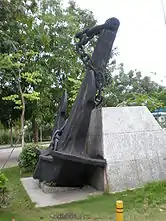
Situated in the Pearl River Delta in China's Guangdong Province, Shenzhen Port is adjacent to Hong Kong. The city's ၂၆၀ km (၁၆၀ mi) coastline is divided by the Kowloon Peninsula into two halves, the eastern and the western. Shenzhen’s western port area lies to the east of Lingdingyang in the Pearl River Estuary and possesses a deep water harbour with superb natural shelters. It is about ၂၀ ရေမိုင် (၃၇ ကီလိုမီတာ) from Hong Kong to the south and ၆၀ ရေမိုင် (၁၁၀ ကီလိုမီတာ) from Guangzhou to the north. By passing Pearl River system, the western port area is connected with the cities and counties in Pearl River Delta networks; by passing On See Dun waterway, it extends all ports both at home and abroad. The eastern port area lies north of Dapeng Bay where the harbour is wide and calm and is regarded as the best natural harbour in South China.
Shenzhen handled a record number of containers in 2005, ranking as the world's fourth-busiest port, after rising trade increased cargo shipments through the southern Chinese city. China International Marine Containers, and other operators of the port handled 16.2 million standard ၂၀-ပေ (၆.၁-မီတာ) boxes last year, a 19 per cent increase. Investors in Shenzhen are expanding to take advantage of rising volume.
Yantian International Container Terminals, Chiwan Container terminals, Shekou Container Terminals, China Merchants Port and Shenzhen Haixing (Mawan port) are the major port terminals in Shenzhen.
Transport
Air
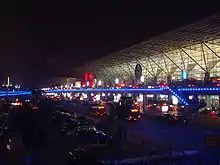
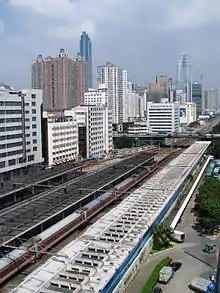

Shenzhen Airlines and Jade Cargo International are located at Shenzhen Bao'an International Airport. The airport is 35 kilometers from central Shenzhen and connects the city with many other parts of China, and serves domestic and international destinations.
Railway
Shenzhen Railway Station is located at the junction of Jianshe Road, Heping Road and Renmin Nan Road and provides links to different parts of China. There are frequent high speed trains to Guangzhou, plus long-distance trains to Beijing, Shanghai, Changsha, Jiujiang, Maoming, Shantou and other destinations. The train from Hong Kong's Hung Hom MTR station to the Lo Wu and Lok Ma Chau border crossings take 43 minutes and 45 minutes respectively.
There is another railway station located in Nanshan District, Shenzhen West (Shenzhen Xi), which is used for a small number of long distance trains, such as the one to Hefei.
Shenzhen North Railway Station (Shenzhen North) opened in 2011 in the Longhua area, handling high-speed trains to Guangzhou South, Guangzhou North, Changsha, Wuhan, Beijing and intermediate stations on the Beijing-Guangzhou-Shenzhen-Hong Kong HSR route.
Shenzhen East Railway Station (Shenzhen Dong) was opened in December 2012. It was originally called Buji station after the suburb it is located and was a Grade 3 station along the Guangshen Railway with no passenger services. Now after massive renovations, it currently handles mostly regional services.
Longgan Railway Station is under construction and will be completed by 2013 to serve high-speed trains on the Hangzhou-Fuzhou-Shenzhen HSR route when it opens in 2013.
Futian Railway Station is under construction and will be completed by 2014. It is completely underground, located in the centre of its namesake Futian District. The central location means it will become the focal point for most high-speed train services on the Beijing-Guangzhou-Shenzhen-Hong Kong HSR route upon completion. Connection to West Kowloon Railway Station in Hong Kong will be made in 2015, allowing for 15 minute cross border train journeys.
Metro
The Shenzhen Metro system opened on 28 December 2004. In phase I, there are only two lines: the Luobao and Longhua lines. Luobao line is from Luohu (Lo Wu and Shenzhen railway stations) to the Window of the World (Overseas Chinese Town). The Longhua line is from Futian Kouan (Futian checkpoint; it was named Huang Gang at first) to Shaonian Gong (Children's Palace).
In June 2011, the Shenzhen Metro extended the Luobao and Longhua lines. The Luobao line runs from Luohu to Shenzhen Bao'an Airport and the Longhua line (now operated by MTR) runs from Futian Kouan (Futian Checkpoint) to Qinghu. Also in June 2011, three lines of the second phase opened before the 26th summer Universiade. They are Shekou line (from Chiwan to Xinxiu), Longgang line (from Yitian to Shuanglong), and Huanzhong line (from Qianhaiwan to Huangbeiling).
Sea
Shenzhen is also connected by fast ferries linking Shekou, on the west edge of the SEZ with Zhuhai, Macau, Hong Kong International Airport, Kowloon, and Hong Kong Island.
Shenzhen has shorelines in its southwest and southeast. Beaches like Dameisha and Xiaomeisha are often crowded with locals and tourists. The Xichong beach, is just one hour drive from Shenzhen's city center, and it still retains its age old natural beauties.
Road
Since February 2003, the road border crossing at Huanggang and Lok Ma Chau in Hong Kong has been open 24 hours a day. The journey can be made by private vehicle or by bus. On 15 August 2007, the Lok Ma Chau-Huanggang pedestrian border crossing opened, linking Lok Ma Chau Station with Huanggang. With the opening of the crossing, shuttle buses between Lok Ma Chau transport interchange and Huanggang were terminated.
Taxis are metered and come in three colors. Red taxis may travel anywhere; green ones are restricted to outside the SEZ, and yellow ones are restricted to inside the SEZ.
There are also frequent bus and van services from Hong Kong International Airport to Huanggang and most major hotels in Shenzhen. A bus service operated by Chinalink Bus Company operates from Kowloon Station on the Airport Express MTR line (below Elements Mall) direct to the Shenzhen International airport.[39]
Tourist attractions

Shenzhen's major tourist attractions include the Chinese Folk Culture Village, the Window of the World, Happy Valley, Splendid China, the Safari Park in Nanshan district, the Dameisha Promenade, Xiaomeisha Beach Resort in Yantian district, Zhongying Jie/Chung Ying Street, Xianhu Lake Botanical Garden, and Minsk World. The city also offers free admission to a number of public parks including the Lianhuashan Park, Lizhi Park, Zhongshan Park and Wutongshan Park.
There are over twenty public city parks in Shenzhen.[40]
Some tourists, however, choose to stay in a largely expatriate and exotic residential community called Shekou, home to a large French cruise liner cemented into the ground called Sea World.[41] Shekou was expanded and renovated in recent years, including claiming additional land from the sea.
Shenzhen's central music hall and library are located in the Shenzhen Cultural Center.
In recent years, the East Coast (shoreline) of Shenzhen has attracted more and more tourists, including backpackers. One of the most famous beaches is Xichong in the south of Dapeng Peninsula.
Culture
- Shenzhen Cultural Center
- Longgang Cultural Center
Media
Shenzhen is served by a variety of daily newspapers, including the Shenzhen Daily
Sports
Shenzhen Stadium is a multi-purpose stadium that hosts many events. The 26th Summer Universiade, the latest one to take place, was held in Shenzhen on 12 August 2011.[42] Shenzhen has constructed the sports venues for this first major sporting event in the city.[43]
Education
Colleges and universities
- Shenzhen University
- Shenzhen Polytechnic
- Shenzhen Radio and TV University
- Shenzhen Institute of Information Technology
- Shenzhen Graduate School of Peking University
- Shenzhen Graduate School of Tsinghua University
- Shenzhen Graduate School of Harbin Institute of Technology
- South University of Science and Technology
High schools
တမ်းပလိတ်:High Schools in Shenzhen
International relations
Twin towns and sister cities
Shenzhen is twinned with:[44][45][46]
 Houston, United States, March 1986
Houston, United States, March 1986 Brescia, Italy, November 1991
Brescia, Italy, November 1991 Brisbane, Australia, June 1992
Brisbane, Australia, June 1992 Poznań, Poland, July 1993
Poznań, Poland, July 1993 Vienne, France, October 1994
Vienne, France, October 1994 Kingston, Jamaica, March 1995
Kingston, Jamaica, March 1995 Lomé, Togo, June 1996
Lomé, Togo, June 1996 Nuremberg, Germany, May 1997
Nuremberg, Germany, May 1997.svg.png.webp) Walloon Brabant, Belgium, October 2003
Walloon Brabant, Belgium, October 2003 Tsukuba, Japan, June 2004
Tsukuba, Japan, June 2004 Gwangyang, South Korea, October 2004
Gwangyang, South Korea, October 2004 Johor Bahru, Malaysia, July 2006
Johor Bahru, Malaysia, July 2006 Perm, Russia, 2006
Perm, Russia, 2006 Turin, Italy, January 2007
Turin, Italy, January 2007 Timişoara, Romania, February 2007
Timişoara, Romania, February 2007 Rotherham, England, United Kingdom, November 2007
Rotherham, England, United Kingdom, November 2007 Reno, Nevada, United States, 30 April 2008
Reno, Nevada, United States, 30 April 2008 Montevideo, Uruguay February 2009
Montevideo, Uruguay February 2009 Kalocsa, Hungary, 2011
Kalocsa, Hungary, 2011 Haifa, Israel, 2012
Haifa, Israel, 2012 Barcelona, Spain July 2012
Barcelona, Spain July 2012
References
- 深圳市2010年第六次全国人口普查主要数据公报[1] (in Simplified Chinese)။ Shenzhen Municipal Statistic Bureau (2014-05-12)။ 4 August 2011 တွင် မူရင်းအား မော်ကွန်းတင်ပြီး။ 2011-07-28 တွင် ပြန်စစ်ပြီး။
- Shenzhen။ U.S. Commercial Service (2007)။ 2008-02-28 တွင် ပြန်စစ်ပြီး။
- Rule, Ted and Karen, "Shenzhen", Hong Kong 2009
- “少帝在赤湾“ Shenzhen 2005
- Zhou and You, 方言与中国文化,Shanghai Renmin Chubanshe 2006
- "The spirit of enterprise fades: Capitalism in China" (2010-01-23). The Economist 394 (8666). Retrieved on 2010-01-28.
- 深圳 最真实的人口数量: 1400万_深圳။ City363.com။ 30 March 2012 တွင် မူရင်းအား မော်ကွန်းတင်ပြီး။ 2011-03-29 တွင် ပြန်စစ်ပြီး။
- 部分年份城乡人口分布 (in Chinese)။ 广东省志:人口志။ Local Records Office of Guangdong။ 20 May 2012 တွင် မူရင်းအား မော်ကွန်းတင်ပြီး။ 2011-08-04 တွင် ပြန်စစ်ပြီး။
- 深圳市第五次全国人口普查主要数据公报 (in Simplified Chinese)။ Shenzhen Municipal Statistic Bureau (2001-04-17)။ 18 April 2012 တွင် မူရင်းအား မော်ကွန်းတင်ပြီး။ 2011-08-12 တွင် ပြန်စစ်ပြီး။
- Expect-the-Unexpected---Bettys-Story&id=6820539
- Age Composition and Dependency Ratio of Population by Region (2004)။ China Statistics 2005။ 2010-07-05 တွင် ပြန်စစ်ပြီး။
- Shenzhen Government Online, Citizens' Life (Recovered from the Wayback Machine)
- Shenzhen Daily 13 June 2007
- 深圳客家人的來歷和客家民居 Hakka Origins and Settlements in Shenzhen။ 中國國際廣播電臺國際線上။ 16 April 2012 တွင် ပြန်စစ်ပြီး။
- 圍頭話 Weitou dialect။ 16 April 2012 တွင် ပြန်စစ်ပြီး။
- 張 ZHANG၊ 則武 Zewu။ 浅谈深圳城中村的成因及其影响 A Discussion concerning the History and Consequences of Urban Villages in Shenzhen။ 4 August 2012 တွင် မူရင်းအား မော်ကွန်းတင်ပြီး။ 10 February 2013 တွင် ပြန်စစ်ပြီး။
- 秦 CHUN၊ 炳煜 Bing Yuk။ "深圳成粵語圈中普通話區 Shenzhen becomes the Mandarin area in a Cantonese region"၊ 7 July 2006။ 16 April 2012 တွင် ပြန်စစ်ပြီး။
- "深圳將粵語精髓融入普通話 Shenzhen Incorporates Cantonese Essence into Mandarin"၊ 15 February။ 16 April 2012 တွင် ပြန်စစ်ပြီး။ Archived from the original on 21 October 2013။
- 中华人民共和国国家通用语言文字法 The National Lingua Franca and Orthography Act-- People's Republic of China။ Standing Committee of the National People's Congress။ 18 May 2012 တွင် မူရင်းအား မော်ကွန်းတင်ပြီး။ 3 May 2012 တွင် ပြန်စစ်ပြီး။
- 广东省国家通用语言文字规定 The National Lingua Franca and Orthography Regulations-- Guangdong Province။ People's Government of Guangdong Province။ 3 May 2012 တွင် ပြန်စစ်ပြီး။
- 深圳市語言文字使用管理暫行規定 The Usages of Languages and Orthography Provisional Regulations -- Shenzhen။ Shenzhen: 深圳市政府 Shenzhen Government။ 1994။
- Top skylines။ Diserio.com။ 17 February 2012 တွင် မူရင်းအား မော်ကွန်းတင်ပြီး။ 2010-05-05 တွင် ပြန်စစ်ပြီး။
- # of +200m Buildings။ CTBUH။ 2 June 2013 တွင် မူရင်းအား မော်ကွန်းတင်ပြီး။ 2012-06-03 တွင် ပြန်စစ်ပြီး။
- "Contact us." Huawei. Retrieved on 4 February 2009.
- Official PRC announcement။ gov.cn။ 2011-01-09 တွင် ပြန်စစ်ပြီး။
- RightSite.asia | Shenzhen Hi-Tech Industrial Development Zone။ En.wikipedia.org။ 2011-03-29 တွင် ပြန်စစ်ပြီး။
- Rightsite.asia
- one-stop portal of the Hong Kong SAR Government / 香港政府一站通။ GovHK။ 2010-05-05 တွင် ပြန်စစ်ပြီး။
- HKG Monthly Digest of Statistics
- HKG Traffic and Transport Digest
- HKG Cross Boundary Survey 2004
- HKG Shipping Statistics
- HKG Trade and Industry Statistics
- Hong Kong International Airport – Your Regional Hub with Worldwide Connections and Gateway to China။ Hongkongairport.com။ 2010-05-05 တွင် ပြန်စစ်ပြီး။
- HKG Cross Boundary Survey 1999 & 2003
- 2007–08။ Policy Address (2007-10-10)။ 2010-05-05 တွင် ပြန်စစ်ပြီး။
- 大汉网络။ SZ-HK metropolis on agenda။ Paper.sznews.com။ 22 January 2010 တွင် မူရင်းအား မော်ကွန်းတင်ပြီး။ 2010-05-05 တွင် ပြန်စစ်ပြီး။
- Shenzhen 'worthy' partner for HK။ china.org.cn။ 2010-05-05 တွင် ပြန်စစ်ပြီး။
- 香港九龙机铁站往深圳机场 (in Chinese)။ 2011-07-20 တွင် ပြန်စစ်ပြီး။ “香港九龍機鐵站往深圳機場 (全程行車時間:車程約75分鐘) Kowloon, Hong Kong Airport Railway Station to Shenzhen Airport (journey time: about 75 minutes by car)”
- The City Parks of Shenzhen Archived 16 November 2018 at the Wayback Machine. The City Parks of Shenzhen ~ Retrieved 2 February 2010
- About us။ Szseaworld.com။ 20 April 2011 တွင် မူရင်းအား မော်ကွန်းတင်ပြီး။ 2010-05-05 တွင် ပြန်စစ်ပြီး။
- 2011 Summer Universiade။ International University Sports Federation။ 20 September 2010 တွင် မူရင်းအား မော်ကွန်းတင်ပြီး။ 2010-09-20 တွင် ပြန်စစ်ပြီး။
- Universiade 2011 Shenzhen Archived 18 January 2011 at the Wayback Machine. Photos construction stadiums Universiade Shenzhen
- 友好城市 (Friendly cities) Archived 19 July 2014 at the Wayback Machine., 市外办 (Foreign Affairs Office), 2008-03-22. (Translation by Google Translate.)
- 国际友好城市一览表 (International Friendship Cities List) Archived 13 November 2013 at the Wayback Machine., 2011-01-20. (Translation by Google Translate.)
- 友好交流 (Friendly exchanges) Archived 12 November 2014 at the Wayback Machine., 2011-09-13. (Translation by Google Translate.)
External links
| Wikimedia Commons တွင် Shenzhen နှင့် ပတ်သက်သော မီဒီယာ ရှိသည်။ |
- Shenzhen Government Online
 Wikivoyage ရှိ Shenzhen သို့ ခရီးသွားလမ်းညွှန်များ
Wikivoyage ရှိ Shenzhen သို့ ခရီးသွားလမ်းညွှန်များ- WikiSatellite view of Shenzhen at Wikimapia
Italic text
